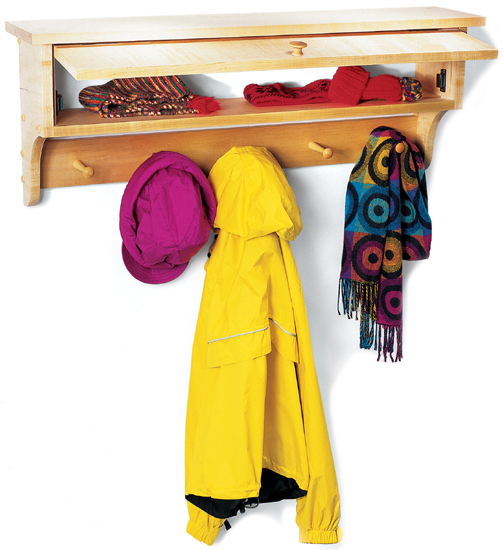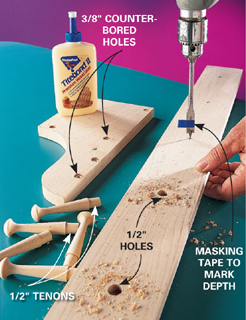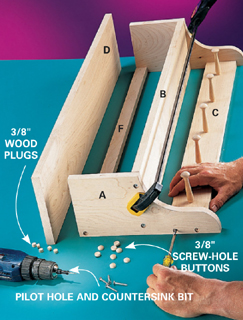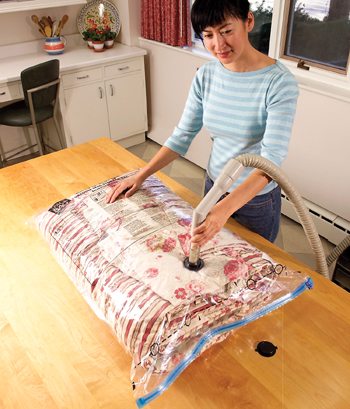

WHAT IT TAKES
Time: 1 day
Skill level: Intermediate
This coat rack is easy to build with butt joints connected by screws that get hidden with wooden screw-hole buttons and wood plugs. It mounts easily to the wall with screws driven through the hidden hanging strip on the back. The five large Shaker pegs are great for holding hats, umbrellas and coats, and the hinged-hatch door at the top keeps the clutter of gloves and scarves from view.
Maple is an ideal wood for Shaker-style pieces, but any hardwood will do. All you need for this project is wood, hardware and varnish.
First transfer the pattern measurements in Figure A (using a compass), and then cut the sides (A) with a jigsaw. Next cut the top (D) to length and rip the shelf (B) to the width given in the Cutting List, p. 49. Cut the hanging strip (F) and the peg strip (C) to the same length as the shelf (B). Now drill the 3/8-in. counterbore holes for the screw-hole buttons (with your spade bit) 3/16 in. deep into the outsides of parts A (as shown in Figure A, and Photo 2). Also drill the 3/8-in. counterbore holes in the top. These holes must be 3/8 in. deep.
Mark and drill the 1/2-in. holes for the Shaker pegs in the peg strip. Drill the holes for the Shaker pegs perfectly perpendicular to the peg strip to ensure they all project evenly when glued in place.
NOTE:
Be sure this project is screwed to the wall studs. Drill two holes into the hanging strip at stud locations and use 2-1/2-in. or longer wood screws.
Lay the pieces on your workbench, as shown in Photo 3. Align the hanging strip (F), the shelf (B) and the peg strip (C) as shown and clamp the sides (A) to these parts. Predrill the holes with a combination pilot hole/countersink bit using the center of the counterbore holes as a guide. Next, screw the sides to B, C and F. Fasten the top (D) to the sides in the same manner. Glue and clamp the hatch stops to the insides of parts A, as shown in Figure A. To finish the assembly, cut the hatch (E) to size and install the hinges to the underside of part D and the top of the hatch. Now glue the buttons and pegs into their corresponding holes. Use only a small drop of glue for the buttons but be sure to apply a thin layer of glue completely around the plugs. This will swell the plugs for a tight fit.
Lightly sand the entire piece after assembly with 220-grit sandpaper. Apply two coats of clear wipe-on polyurethane to all the surfaces (remove the hinges and knobs). Once the finish is dry, add two magnetic catches to the hatch-stop molding (G).
KEY |
PCS. |
SIZE & DESCRIPTION |
A |
2 |
3/4" x 6-1/4" x 14" maple sides |
B |
1 |
3/4" x 6-1/4" x 32-1/2" maple shelf |
C |
1 |
3/4" x 3-1/2" x 32-1/2" maple peg strip |
D |
1 |
3/" x 7-1/4" x 36" maple top |
E |
1 |
3/4" x 5-13/16" x 32-5/16" maple hatch |
F |
1 |
3/4" x 1-1/4" x 32-1/2" maple hanging strip |
G |
2 |
3/4" x 1/2" x 6" maple hatch stop |
Materials list
ITEM |
QTY. |
1-1/2" no-mortise hinges |
1 pair |
1-1/4" beech knob |
1 |
Narrow magnetic catch |
2 |
3-3/8"-long Shaker pegs |
5 |
3/8" screw-hole buttons |
10 |
3/8" plugs |
5 |
3/8" spade bit |
1 |
1/2" spade bit |
1 |
1-5/8" wood screws |
15 |
Wood glue |
1 pint |
Wipe-on polyurethane |
1 pint |
150- and 220-grit sandpaper |
|

2
Drill the 1/2-in. holes 5/8 in. deep for the 3-3/8-in. Shaker pegs. Drill the 3/8-in. counterbore holes 3/16 in. deep for the screw-hole buttons in the sides (see Figure A, Detail 1).

3
Assemble the shelf by clamping parts C, F and B to the sides. Drill pilot holes and screw the pieces together. The screws will be covered by the buttons and plugs.
Ever try, unsuccessfully, to fit 10 lbs. of blankets into a 5-lb. bag? Now you can do it with ease. Space-saving storage bags use a vacuum cleaner to ensure that you’re only storing stuff, not air.

If you put lots of winter clothes and bedding in storage every spring, then spend the summer trying to stop the bulky winter stuff from tumbling out of closets and drawers, you’ll like these bags. Just fill the bag with clothes or bedding, seal the top, and pull the air out using a vacuum. Seal the vacuum port and you’re good to go. The bags can be reused, so come fall you can store your summer stuff.
No matter how you put items into the bag, the vacuum suction will compress them. However, the more neatly you fill the bag, the flatter it will end up. Various sizes are available, so you can match the size to the items you’re storing. Several brands of these bags are sold at big-box stores and online.
